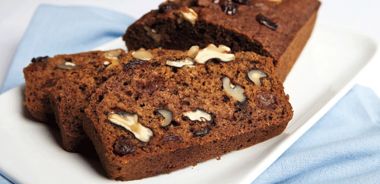Maple Pumpkin Tea Loaf

Using pumpkin purée in place of much of the oil makes this deeply spiced loaf deliciously lower in fat.
1 1/2 cups (350 mL) whole wheat pastry flour
1 tsp (5 mL) baking soda
1/2 tsp (2 mL) nutmeg
1/2 tsp (2 mL) cinnamon
1/2 tsp (2 mL) allspice
1/4 tsp (1 mL) salt
2 large eggs
1/2 cup (125 mL) maple syrup
1/4 cup (60 mL) vegetable oil
1 cup (250 mL) pumpkin pur'ee
1 Tbsp (15 mL) loose leaf black tea, finely ground
1/2 cup (125 mL) walnuts, chopped
1/2 cup (125 mL) dried cherries
Preheat oven to 350 F (180 C).
In large bowl, stir together flour, baking soda, spices, and salt.
In separate bowl, lightly beat eggs and mix in maple syrup, oil, pumpkin, and black tea.
Add wet ingredients to dry and mix until all the flour is moist. Fold in walnuts and cherries.
Pour into greased 9 x 5 x 3 in (2 L) loaf pan. Bake for about 50 minutes or until a tester inserted into centre of loaf comes out clean. Let cool before unmoulding.
Serves 8.
Each serving contains: 276 calories; 5 g protein; 13 g total fat (1 g sat. fat, 0 g trans fat); 38 g carbohydrates; 4 g fibre; 86 mg sodium
source: "A Touch of Maple", alive #340, February 2011





